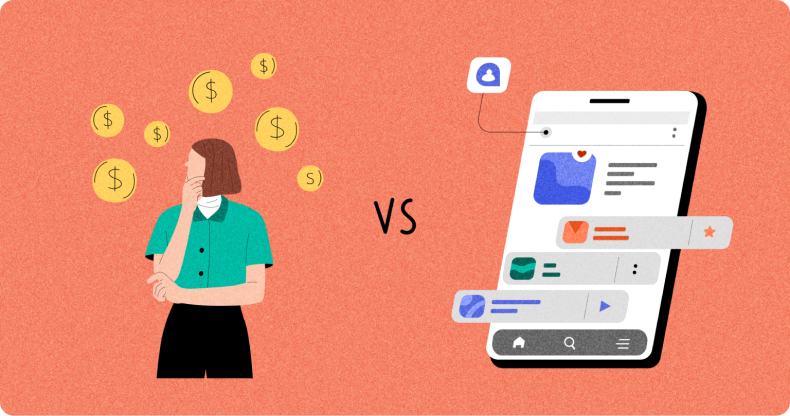The mobile product manager’s guide to driving more engagement with fewer features

The tech sector is taking a hit with budget cuts and layoffs, so product managers must do more with less.
When faced with limited resources, how can you attract more customers and deliver impactful business results within your mobile app? This question is important whether you’re building on a strict budget or not – and often prompts another question: Are we building in-house, or buying?
Motive needed a robust messaging solution for their already established platform and network of 1 million drivers and over 70,000 customers. Building a chat function to support that amount of volume is a difficult task, but with Sendbird, customers saved time and costs from improved communication.
“After our last chat API vendor couldn’t support us anymore, financial viability was as important to us as product features” said Senior Product Manager, Jason Pesek. “In Sendbird, we picked a partner who we can invest in for the long term.”
Here are six ways to build an engaging mobile app without hiring extra developers or breaking the bank.

1. Keep it simple and goal-oriented
Simplify your app’s functionalities and create a streamlined UX to help users achieve their goals with minimum frustration and glitches.
It’s tempting to incorporate complex design ideas right out of the gate. Unless you have the time and resources to get them to work seamlessly without a glitch, building too much too soon often results in a confusing and frustrating user experience (UX).
Make sure your goals are clear from the very beginning. Establish business objectives, identify KPIs, understand who your target audience is, who your competitors–and so on. You should know the key problem(s) your app will solve like the back of your hand. Then, use these insights to narrow down the features to include in your initial launch.
Sendbird tip: When building, come back to your business objectives again and again. Design a user flow that specifically builds upon these objectives — that’s usually your best bet to keep your app user-friendly.

Elevate in-app engagement eBook
2. Identify a unique positioning
Yes, there is a market for being the app that does everything and serves everyone, but providing a unique solution to a specific market can achieve more impactful results.
If you focus your budget on building an app that solves one problem for a specific audience, you can gain traction in the market and gather glowing reviews to support further monetization and expansion.
A unique positioning is often more than just features. For example, you may take an existing functionality and position it to serve a specific audience. Or, you may add a unique twist and infuse your brand value into the user flow to make the app resonate with your target market.
MonPay is the financial services subsidiary of MobiCom Corporation, the largest mobile phone operator in Mongolia. While MonPay had a robust user infrastructure for their finance service, as the company’s user base exponentially grew, MonPay found themselves missing a core component that they believed would significantly elevate their user experience; messaging and chat capabilities.
With Sendbird, there has been a proven increase in retention as MonPay users engage more within the app because of its community culture and unified payment experience. Users can now socialize and form group chats with up to 20 others and have made mundane tasks such as splitting bills much more fun and enjoyable.
3. Test the water with an MVP
A minimum viable product (MVP) approach allows you to roll out an app with essential features to meet your audience’s needs and deliver the value you promise without building the entire roadmap perfectly from the start.
You can use the opportunity to collect user feedback, understand market demand, validate the product idea, refine your product roadmap, gain traction in the market, and create a proof of concept to secure more budget.
What should you include in your mobile app’s MVP? Identify features that are most valuable from the users’ perspective and support the value proposition of the full-featured product. It should also address industry trends and help you stay on top of the latest market demands.
Once you launch your MVP, you can analyze user data to validate your strategic direction and refine your feature list for future releases.
4. Adopt a user-centric design process
App maintenance costs around 20% of the initial app development budget. Keeping things simple and thinking user-first is a great way to decrease these costs down the line.
Good UX is the key to success for any application. A user-focused design process helps you create an app that people will engage with while avoiding spending money on irrelevant features.
Start the design process with a UX workshop to ensure that the final product will have an intuitive and easy-to-use interface that meets your target audience’s needs. You can also conduct user testing with paper or clickable prototypes to refine the user flow.
Identifying issues and validating your ideas before starting the development process can help you save money and ensure that you include the must-have features from the get-go.
Who knows, maybe going straight to the user will allow you to save money to add new features later on.
5. Consider cross-platform development
Apps native to each platform (i.e., iOS, Android) offer better performance, higher scalability, and broader functionality. However, you’ll need to create and maintain two codebases, which will almost double your cost and development time.
On the other hand, cross-platform development uses a single codebase, making the process less costly and time-consuming. However, you may run into performance, UX, and functionality limitations.
If you start with a simple app that doesn’t involve complex animation or logic and doesn’t require access to all of a phone’s resources or services, consider cross-platform development as a cost-effective approach to get up and running.
6. Buy instead of build
Instead of building every functionality from scratch, use software development kits (SDKs) to avoid spending months or even years reinventing the wheel. These out-of-the-box functionalities, such as Sendbird’s API for chat, voice, and video calls, allow you to roll out new features quickly, shorten time to market, and maximize your ROI.
You can leverage best-in-class user interface (UI) design that consumers already love to deliver an intuitive and engaging experience. Meanwhile, the pre-built framework and tried-and-true features help you save time and money on UX design, prototyping, and testing.
If you’re in a highly-regulated industry (e.g., healthcare and finance,) you can rest assured that your chat function is always compliant with industry regulations and standards, including HIPAA, SOC 2, GDPR, and ISO 27001, when you use Sendbird. Additionally, we take care of all the maintenance and upgrades to help reduce your ongoing costs.
Try Sendbird for free to see how easy it is to build an engaging app with fewer resources.










